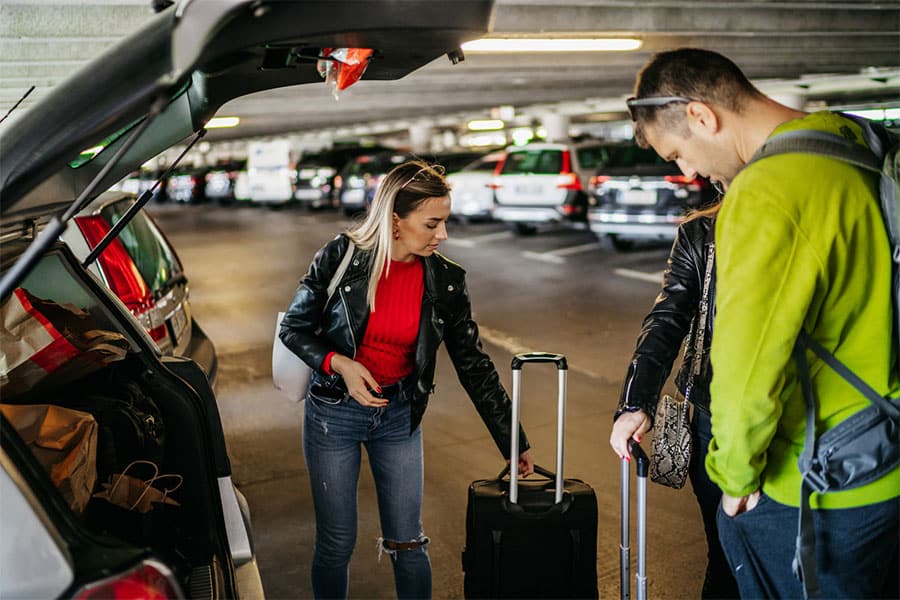When airports first started popping up, they merely acted as a simple transfer point between the ground and the sky. Parking was not plentiful, so travelers had to be dropped off. It wasn’t till 1954 when the first automated parking lots were built where, for a fee, drivers could enter and exit the lot by raising and lowering the boom. With the introduction of paid parking lots, lots with security and lighting were also introduced.
As air travel became more and more common and airports became busier and busier, parking lots became an integral part of any airport’s design. Airports are now much more than a transfer point. With the evolution of security, technology, and usage, airport parking lots have adapted to newer and more demanding patterns of passenger movement.
Today, DTW airport parking offers convenience, security, and peace of mind for travelers on the go.
Six Types of Airport Parking
Let’s take a look at the six main types of airport parking:
- Drop off and pickup zones: With this, vehicles are allowed curbside access to the terminal entrance – usually for less than 15 minutes.
- Cell phone waiting lots: These are remote lots that are free or very cheap for drivers to park while waiting to pick up a traveler on arrival.
- Short-term parking: These lots are for drivers who plan to be in the airport for no more than four hours.
- On-site long-term parking: This is where travelers can park their cars for the entire length of their trip.
- Off-site long-term parking: Travelers get discounted parking spaces for the entire duration of their trip. This type of parking lot is usually not affiliated with the airport.
- On-site car rental lots: This is where rental companies provide rental cars at the airport.
Drop-off and pick-up zones
Located close to the terminal, these zones require curb space. Private cars, valets, shuttles, taxis, limos, and ride-sharing vehicles such as Uber and Lyft usually use these spots. Transit buses may also service these front-of-terminal spaces.
Departure, AKA drop-off zones, often have less driver “dwell time” than arrivals (AKA pickup zones). Dwell time refers to how much time a vehicle takes up space at the curb. Typically, taxis, shuttles, and private vehicles just need enough time to get their luggage out, give a quick hug goodbye to loved ones, and that’s it.
That being said, valet services spend longer times at curbside, marked by a dedicated zone and kiosk.
Pick-up zones get more complicated when you add in ride-sharing companies, as well as shuttles from off-site parking lots. Private drivers who are unclear when their friends will be emerging tend to taking longer dwell times as well.
Pick-up areas should be clearly segregated into zones by islands, crosswalks, speed bumps, and signs directing traffic flow.
Cell phone waiting lots
These lots are designed to shorten vehicle dwell time within passenger pick-up zones. If you’re picking up passengers from a terminal but aren’t sure if they’ve landed or picked up their bags yet, you can wait for short periods of time in the cell phone lots, which reduce congestion at pickup zones. The traveler will text or call when ready to be picked up.
Short-term parking
This is typically offered within a multi-level parking garage located close to the terminal, featuring the highest hourly rates. You may choose this option if you are escorting friends or family members into the airport or if you’re meeting your party at arrival. This allows for easy pickup and drop off for just a few hours without the expense of paying for longer term parking that will go to waste.
On-site long-term parking
Also known as remote parking, these lots allows travelers to leave their cars at the airport while they go on their trip. Business travelers are frequent customers of these lots. Shuttles bring them from this lot right to the airport entrance. Some long-term parking lots provide concierge services such as car washes, details, gas fill-ups, and oil changes. This is what we offer here at Valet Connections!
Off-site long-term parking
These lots are usually available near major airports, operated by companies unaffiliated with the airport. Fees are usually cheaper than parking on site, and discounts may be offered, as well as shuttles to and from the airport.
Car rental parking
Airports often partner with car rental companies to provide rental options, whether pre-booked or booked while at the airport terminal.
Airport Parking: A Business
Let’s break down the business of a typical airport. Interestingly, only 56% of airport revenue is aeronautical in nature. Nearly 40 percent of an airport’s revenue comes from non-aeronautical services, such as retail, parking, and services. Parking comprises 20 percent of that, earning between $12 and 13 billion dollars each year.
At most major airports, private vehicles comprise a smaller percentage of transportation than just 10 years ago, with the increasing popularity of ride shares, rental cars, taxis, shuttles, and limos. But that being said, there has been a big increase in passengers, which prompts airports to manage that congestion in an efficient way.
When planning parking lots and sizes, airports have to consider peak occupancy and how congestion will affect traffic flow. Large lots are considered full when at 85 to 95 percent occupied. Cars looking for a space will create congestion, resulting in lower capacity with a poorly-designed lot. Airports must determine passenger levels on the busiest days in order to ensure all parking lots can accommodate all possible passengers and visitors.
Contact Valet Connections DTW Parking
DTW airport parking has evolved over the years just like airports have. We are proud to say we offer our customers the utmost in convenience and luxury so they can enjoy stress-free vacation and business travel. Book with Valet Connections now when you call us at (734) 992-4946. Reserve your spot early and ask us about our concierge services to make your life easier.


